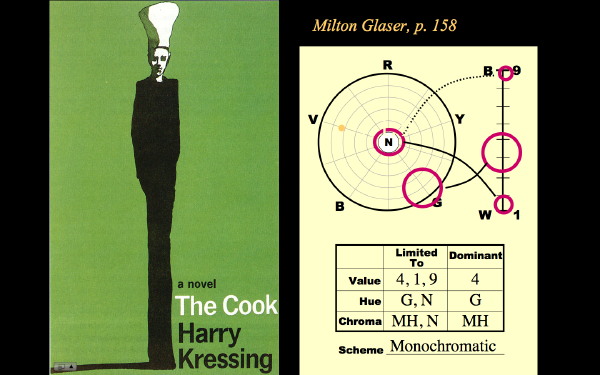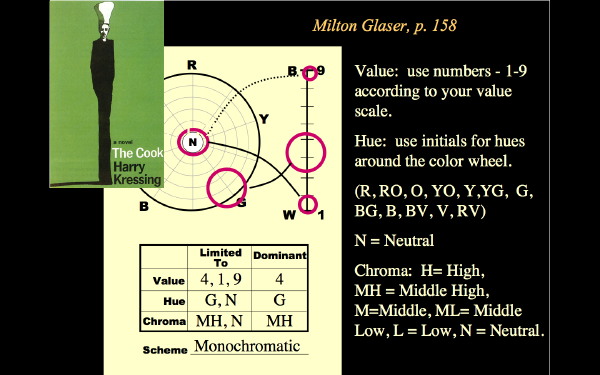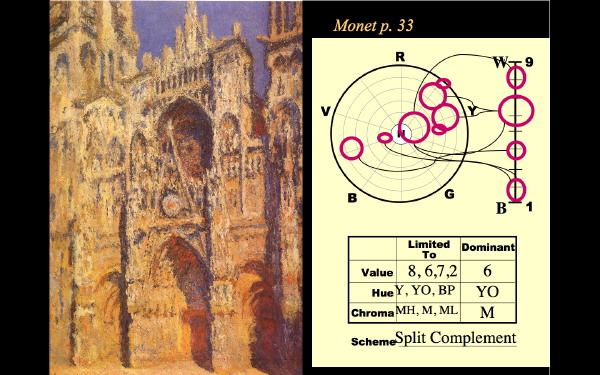We started with this rather simple book cover illustration by Milton Glaser.
Make sure you know what each mark (each circle and line) mean.
Circles inside the main color wheel communicate hue and chroma (where the circles are positioned) and amount/proportion (size of the circle)
There are only two circles in the color wheel —
— Mid-High Chroma Green. (most of the composition is this bold, solid, unwavering green.
— Neutral — both black, white and gray are represented by the circle in the middle.
— (arguably, there needs to be a small, low-chroma green circle, representing the shadow area of the hat.)The value staff shows only three distinct values in Glaser's composition.
(note...the chart has "B" and "W" reversed...sorry, my bad.)
— white (small circle at the top)
— value-4 green (largest circle)
— black (mid-size circle at the bottom)
Notice that the sizes of the circles vary. The size of the circle communicates roughly how much color there at that value.The lines connecting the value staff and color wheel are the actual colors — only the lines represent hue, chroma AND value.
— the upper line (dotted) connects Neutral hue/chroma to high/white value. Thus, the color represented is white.
— the middle line connects Neutral hue/chroma to low/black value — value 1. Thus, the color represented is black.
— the bottom line connects high-chroma green to value-4. So the color represented is a vivid green.
The lower portion basically restates information in the color wheel-value staff. However, the lower table draws attention to dominances and limitations — an important pair of ideas in color harmony.
Dominance are those features that are most prominent or influencial in the composition.
Limitations inventory all of the features used in the composition. (see Limited Palette)Each of Hue, Value and Chroma have dominances and limitations identified.
Dominant Value: 4 (look back at the value staff...where is the biggest circle, or cluster of circles? That's where the dominant value is.)
Dominant Hue: G (green) (clearly green dominates. But you can look at the color wheel. Where are the biggest circles?)
Dominant Chroma: MH (middle-high). (Look back at the color wheel...where is the biggest circle...or, at what distance from the center is the biggest cluster of circles?)Value Limitations: (which values are actually being used in this design?) 4, 1, 9 (look back at the value staff...where are the circles?)
Hue Limitation: G, N (green & neutral) Where are circles on the color wheel?
Chroma Limitation: MH, N (middle high & neutral) On the color wheel, the center is circled (N) and there is a circle far out, at the MH level.Scheme: the color scheme is discerned from the pattern of circles in the color wheel. Your text (Color 6th ed., p. 122) outlines some of the most common schemes.
Here, Glaser is using only one hue (Green) , plus neutral. The scheme is monochromatic (or Monochromatic with Neutral).
Monet's color compositions are always more complex and subtle than those of most painters — color is his native territory.
The color wheel shows three distinct hues: Yellow (slightly yellow-orange), Orange (Yellow-Red, to Mr. Munsell), and Blue-Violet. This creates a roughly Y-shaped structure that is a type of split-complement scheme.
There are two prominent chromas represented: Low and MH (middle-high) (there are also high-chroma accents in orange)
Four values are charted: 2, 4, 6, 8. The most prominent value is at value 6 — where the largest circle is drawn.
The lines connecting the color wheel and value staff get a bit busy here...that's not uncommon. Though there is important information in the lines, it is more often the pattern of circles that conveys the essential color structure and value structure.
Dominant Value: as noted, the largest circle on the value staff is at Value-6.
Dominant Hue: Yellow or YO (yellow-orange dominates.
Dominant Chroma: Mid-chroma is where the largest groups of circles are clustered on the color wheel.
The Limitations note each mark on the color wheel and value staff (e.g. there are four circles on the value staff, and four values noted in the value-limitation.)
see also: Color Charting Intro | Color Proportion Studies | Color Charting Exercises


